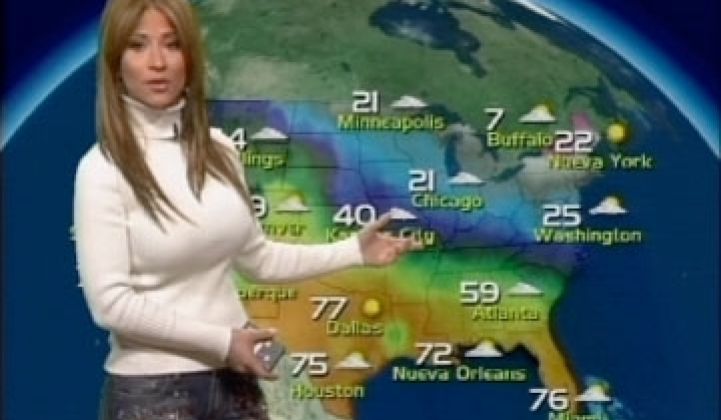It turns out you do need a weatherman to know which way the wind blows -- and where the sun is shining -- if you plan to produce or transmit electricity from renewable energy. Two of the world's most respected providers of "intelligence" on wind and solar energy resources are AWS Truepower and 3TIER. The intelligence falls into two distinct categories: assessments and forecasts.
"Assessment is about where to put the project so it produces power when you need it based on a 40-year projection," Ken Westrick, 3TIER's CEO, said. "Forecasting is really about integrating that power into the grid cost-effectively, reliably and efficiently in the short-term."
Assessments and forecasts serve different consumers of sun and wind. "In the assessment side, it's developers and financiers," Westrick said. "On the forecasting side, it's power marketers, project operators and system operators."
"One thing I want to clarify," Bruce Bailey, the AWS Truepower CEO said, "is to us, most forecasting applications are scheduling next hour, next day, for grid operators primarily. But we also do long-term projections (also referred to as assessments), like 20-year projections of [project] energy output. We'll quantify the levels of probability of reaching different levels of performance for wind and solar systems."
Weather forecasting for and assessment of wind and solar has grown up with the renewable energy industries. Ten years ago, Bailey, trained as a meteorologist, was doing weather forecasting. "It's become much more sophisticated and much more accurate," Bailey said of the ten years since Southern California Edison retained him to do forecasts on their incipient wind resources. "Part of it is experience. Part of it is better feedback from the plants themselves. And third, we've installed more wind monitoring equipment within the area of interest so that we just have more real-time information."
Their services have never been in greater demand. T. Boone Pickens referred to 3TIER wind maps when he told 60 Minutes that the Midwest is "the Saudi Arabia of wind" and he took the maps with him when he testified before Congress.
In the last two years, assessments have become a lifeline for wind and solar installations because they can be determinative for funding. "Since this economic slowdown, now that money is being valued a lot more, people really do care about building productive projects, " 3TIER's Westrick said. "There has been a fundamental shift and we are getting a lot of acknowledgement that our technologies are objective, accurate and they quantify uncertainty. That's what bankers and financiers need right now as capital has become much harder to get."
Neither company was loose with client names. AWS Truepower mentioned that they had worked for SCE and 3TIER talked about Pickens but no other names were mentioned. Todd Stone, the 3TIER Director of Communications, explained why. "The world of developers and even operators is very secretive," Stone said. "The data that we provide for them and the projects that they're working on are just not something we're at liberty to speak about."
"We're the leading provider of wind forecasts in North America to ISOs and utilities and provide assessment services to all of the major wind and solar developers throughout the world," was as specific as AWS Truepower would be. 3TIER would only say it does assessments for "all of the world's largest developers of wind and solar on a global basis" and it does forecasts for "most of the major project operators, a lot of the major utilities and at least a couple of the system operators."
It was irresistible to draw both companies out on the subject of climate change. AWS Truepower's Bailey, a cautious businessman and scientist, insisted he currently has limited market demand for climate information from his primary customer base and then pointed out that long-term climate models are of controversial accuracy due to the challenge in validating them.
Dr. Scott Eichelberger, 3TIER's Director of Advanced Applications, offered a more intriguing insight. He admitted that 3TIER draws on data from the many International Panel on Climate Change (IPCC) climate models and has found it to be accurate. "The IPCC is an authoritative body and the best estimate of what the future will be as far as climate change goes," Eichelberger said. "They go through and actually combine together climate models from around the globe and there's a whole host of estimations for what the future will be."
"These are projections that go out to 2040 or 2060 and beyond," Westrick added. "There's really no way to validate them right now." But, he said, "We run these models everyday. We know the next day if the model isn't right because our customers let us know."
Both companies expect their assessment and forecasting capabilities to get better. Dr. Eichelberger said computational abilities, numerical modeling and real-time feedback will all improve.
Marie Schnitzer, AWS Truepower's Director of Solar Services, was more specific. "The one shift in focus is with the utilities within the solar space -- and it reflects where it is in the wind space -- is they're looking for a finer resolution. Rather than something that is an annual average or an hourly projection for the longer term and potential impact to the grid, it's looking at it in a 10-second, 5-second or a 1-second impact to the grid."



